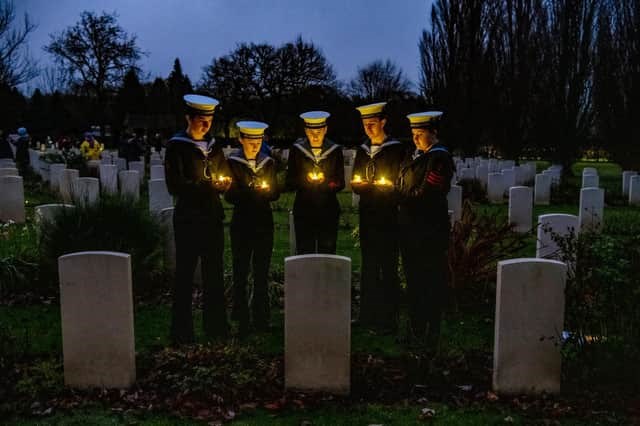MOOSEJAWTODAY.COM — An English town recently held a candlelight service to honour Canadian airmen who died during the Second World War and are buried in a nearby cemetery.
More than 1,000 casualties are commemorated at Stonefall Cemetery in North Yorkshire, which the Commonwealth War Graves Commission (CWGC) maintains. Many casualties — over 660 from Canada and others from Australia, New Zealand, Jamaica, Trinidad and Fiji — were bomber crews and are buried adjacent to their comrades.
The cemetery is one of northern England’s largest CWGC sites. The first burial occurred in 1943; by 1944, more than 550 airmen had been interred at Stonefall.
After the Second World War, the Royal British Legion established a committee that encouraged local families to adopt a grave. The committee also wrote to Canadian relatives of the dead, offering to lay floral tributes.
Residents of Harrogate — 350 kilometres northwest of London — have continued to honour the war dead for 78 years.
A new tradition that resident Benji Walker started five years is placing tealights on the graves to honour the fallen airmen. She has a son serving in the Yorkshire Regiment and was inspired by the images of CWGC cemeteries in Europe lit by candlelight.
This tradition continued this past Christmas as residents visited the cemetery on Dec. 18 for a service of remembrance.
“I view it quite simply: if it wasn’t for their sacrifice, we wouldn’t be here able to remember them. Everything would have been so different,” Walker told the Yorkshire Post newspaper.
“It’s quite easy to forget exactly what they gave up, plus there are soldiers out there still fighting in Ukraine. This year also we lost the Queen and she gave everything for her country.”
Walker uses the event to raise money for the Commonwealth War Graves Foundation and charity Help for Heroes.
The website www.yorkshire-aircraft.co.uk lists all the airmen who died while training, taking off or landing at nearby airfields during the war.
There are 64 Saskatchewan men buried in the cemetery. One died in 1940, four died in 1941, 15 died in 1942, 13 died in 1943, 26 — including three from Moose Jaw — died in 1944 and five — including two from The Friendly City — died in 1945.
Moose Jaw’s Flight Officer Robert George Smith was a wireless operator/air gunner on the seven-man Halifax bomber NA190, which met a terrible end on March 5, 1945 — two months before the war finished.
The airplane was part of 420 Squadron, which began taking off from Tholthorpe airfield at 4:29 p.m. for a mission to Germany. During the afternoon, an unexpected freezing fog layer moved into the area, resulting in planes climbing into the clouds, freezing up, and sometimes crashing.
Bomber NA190 climbed to the required height and avoided the initial icy blackspot. However, the freezing cloud layer covered a large area and iced up the airplane’s controls.
Farmer Frederick Wharton was ploughing a field near Hayton Wood, Aberford, when he heard the aircraft flying toward him.
He heard the engines cut out before restarting again. Having lost height, the bomber appeared below the clouds, flying reasonably level. However, one crewman bailed out, and the engines died seconds later.
The plane’s nose dropped and it smashed into the ground near Aberford at 5:20 p.m. The bomb load blew up upon impact, creating a deep crater and throwing plane pieces across 20 fields.
Wharton avoided the falling burning debris and ran to the crash site to help. The survivor — Flight Sgt. James Harry Waugh — met Wharton, who directed him to a telephone at Hazelwood Castle a kilometre away. The airman ran to report the crash and was later given an award for his efforts.
Robert Smith was born to Joseph and Florence (née Andrews) on April 9, 1923. He studied at technical college and worked as a stock and parts man for several businesses.
Smith enlisted in the air force at age 19 in Regina on May 28, 1942, and after training, was shipped to England in June 1943. He served in several squadrons before being assigned to 420 Squadron on Dec. 30, 1944.
His headstone at Stonefall Cemetery is located at H/H/16.




